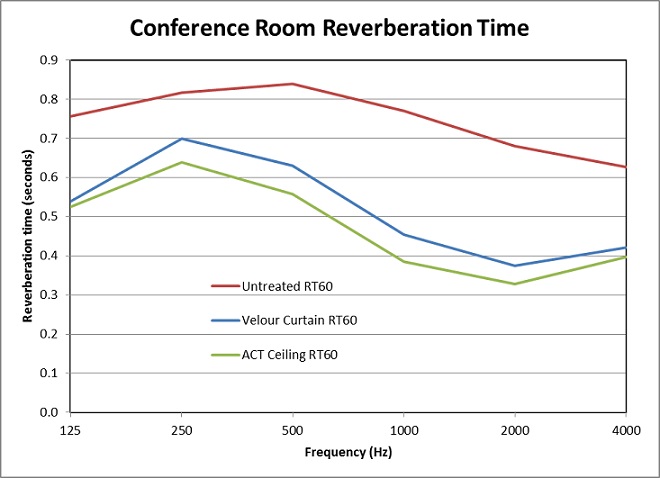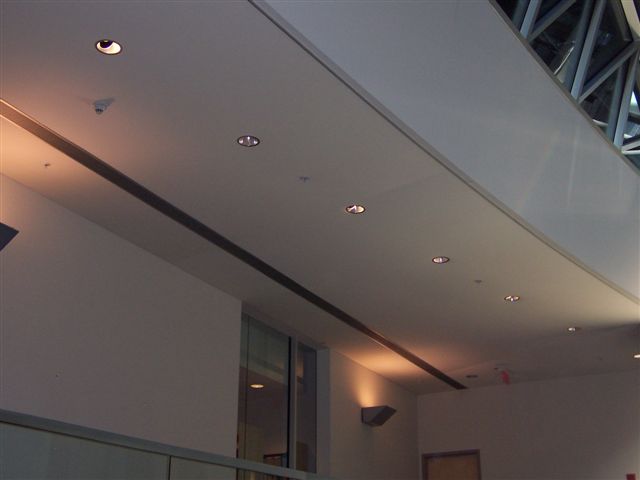Introduction
David Coate Consulting (DCC) conducted a site visit of Avention’s new office space build out in Concord, Massachusetts. The main objective of this study was to perform acoustical tests in the main existing conference room and recommend acoustical treatments to improve the acoustics in the space. Interior finishes in that space are highly reflective and cause problems both in terms of speech intelligibility within the space as well as speech intelligibility during conference calls via microphones located in the conference room.
In addition, DCC reviewed (but performed no acoustical tests) the acoustics in the
• Conference room currently under construction
• Open office area
• Lobby
Main Conference Room
Excessive reverberation is the cause of the speech intelligibility issues in the main conference room. “Reverberation” refers to the combined effect of multiple reflections within a space. Reverberation increases with increasingly hard/reflective surfaces and size of the room. In general, speech intelligibility decreases with increasing reverberation time. The RT60 (reverberation time) is the time in seconds for sound levels to decay 60 decibels (dB). Very reverberant spaces, such as gymnasiums, may have RT60 values of 3 to 5 or more seconds. Recommended criteria for conference rooms is 0.6 to 1.4 seconds, in the mid-frequencies. Using a high performance sound system to excite the space with pink noise bursts, the RT60 was measured at 15 locations within the conference room. The data was processed in octave frequency bands using a real time spectrum analyzer. Figure 1 shows the results of these tests. Existing conditions are labeled “untreated RT60” which reveals that the maximum RT60 occurs in the mid-frequencies (e.g., 500 Hz) at 0.8 seconds. While this value does fall within the acceptable range for conference rooms, so called “specular reflections” or discrete reflections between hard parallel surfaces compound speech intelligibility issues in this space. It is likely that speech intelligibility would be noticeably improved by reducing the RT60 to 0.6 seconds and by reducing specular reflections. Specular reflections can be addressed by adding acoustical absorption to at least one of the parallel reflective surfaces.

Acoustical Model and Recommendations
Conference room dimensions, architectural finishes, and measured RT60 data were used to develop a computer model to replicate the existing acoustics. Next, various acoustical absorption treatment options were auditioned in the model to reduce the reverberation time to an acceptable level.
The “Velour Curtain RT60” curve in figure 1 corresponds to the addition of an 18 Ounce weight or greater (heavy) velour curtain that would cover the existing glass wall.
The performance of this treatment relies on maintaining several inches of airspace between the curtain and glass. The curtain could be retracted at times, but for optimum acoustics the curtain would need to essentially cover the glass wall. A second treatment option, covering the entire ceiling with Acoustical Ceiling Tile (ACT), was also analyzed and the results are shown in Figure 1. The treatment assumed was 5/8” thick absorptive ACT. This treatment option has slightly better reverberation time performance than the velour curtain option, also with a mid-frequency RT60 at 0.6 seconds. However, the velour curtain option would likely reduce specular reflections somewhat better than the ceiling treatment option simply because glass is a highly reflective surface.
The untreated Speech Transmission Index for this room is 0.84. STI ranges from 0 to 1, with 1 being equivalent to 100% speech intelligibility. Assuming a 10 foot separation distance between speaker and listener, 84% of speech would be understandable in this room. Either treatment option would increase the STI to 0.93 or 93% speech intelligibility. Please not that this should also improve speech intelligibility via the microphones in the space, but these STI values would not apply to off-site listeners.
Either treatment option will also reduce overall sound levels in the space by a few decibels.
Ideally, the curves in Figure 1 should be relatively flat, but achieving better low-frequency performance would require a different type of absorber with a deeper airspace behind it, which would be more difficult and expensive to construct in this retrofit situation.
Conference Room Under Construction
The conference room under construction has smaller dimensions and volume than the main conference room and therefore its RT60 should be inherently lower than that of the main conference room. However, similar acoustic treatment schemes such as discussed in the main conference room section could be employed with similar benefits. Specular reflections should be avoided by avoiding hard reflective parallel surfaces. We recommend an RT60 of approximately 0.6 seconds for this space.
Open Plan Office Space
The open plan office space has several acoustical issues which affect speech privacy. The central office area has cubicles very close to one another which cause speech privacy issues between cubicles and also customers on phone calls. The main parameters that affect this issue are:
1. Proximity of cubicles to each other
2. Height of cubical walls
3. Sound masking
4. Sound absorption within each cubicle
Increasing the height of cubical walls would improve speech privacy to some degree based on how much the line-of-sight between speaker and listener was broken by the wall. In this case, wall heights (or glass) could be extended a modest amount to break this line-of-sight. That in turn should result in a 5 dBA improvement which would be noticeable. Please note that if glass is used to provide this extension, it should be as massive as possible (tempered or laminated), with no gaps between the walls and glass.
Sound absorptive materials such as the material on the existing cubicle walls can help reduce the amount of reflected sound energy.
I understand that a sound masking system is in place, but its sound was difficult to detect in the open office area. Sound masking alone usually cannot solve speech privacy issues, but it must be carefully balanced between cubicle proximity and wall height.
I would suggest mocking up a test section of the office to experiment with the relationship between wall height and sound masking level. Once you are happy with the outcome, the same approach could be employed for the entire open office area.
In some cases a personal sound masking loudspeaker located on a person’s desk can be an effective supplement to ceiling mounted loudspeakers. A sound masking loudspeaker located close by a person allows overall sound masking levels in a space to be much lower than for ceiling mounted loudspeakers. It may be possible to use the existing computer loudspeakers for this purpose.
Lobby
The lobby is currently under construction, but current plans are for several of the room finishes to be hard and reflective. The main acoustical concern for this space is potentially excessive reverberant sound of the receptionist’s voice heard by people calling the office.
The ceiling and wall constructed with GWB may be potential candidates for sound absorption treatments. Since the unfinished current appearance of the ceiling is planned, a spray-on acoustical treatment could be considered. Multiple spray on treatments are usually required to achieve a sufficient depth of treatment. An example spray on product can be found at
http://www.pyrok.com/
Another treatment option for the GWB wall would be to mount 2 inch thick Owens Corning 703 fiberglass panels on it, hidden behind acoustically transparent and fire-rated fabric. Figure 2 shows an example of this where the ceiling appears to be plaster or GWB, but actually is stretched fabric with acoustical treatment behind the fabric.

More information on this approach can be found at
http://www.fabricmate.com/
I understand that the metal wall behind the reception area has already been ordered, but it is possible to achieve a metal finish with acoustical treatment. An example of such a treatment can be found at
http://www.acousticalsurfaces.com/acousti_metal/acoustimetal.htm
Particularly since available surfaces for treatment are limited in the lobby, I recommend that treatments with high Noise Reduction Coefficients (NRC) be selected.